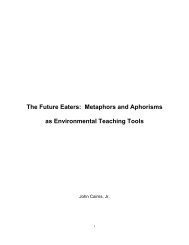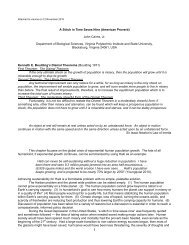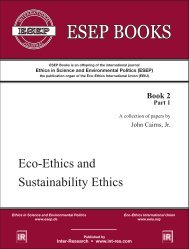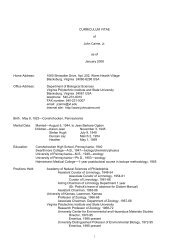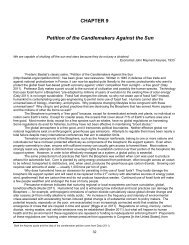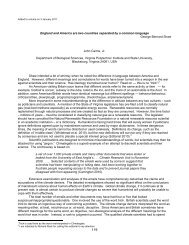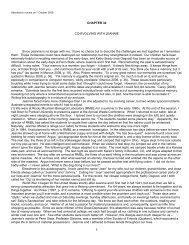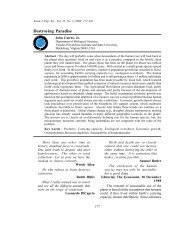254Cairns: Eco-Ethics and Sustainability Ethicscould help with carrying capacity problems, it would be foolish to expect assistance, at present,from outside Earth’s solar system.Humankind may have already passed the planet’s long-term carrying capacity for humans sincenatural capital is being used more rapidly than it is being replaced. Even if this limit has not beenreached, continued exponential growth of both population and rate of resource consumption ensuresthat humankind will soon reach or exceed it. Although the scale for Earth is much larger than inthe two islands, the basic issues are quite similar.EASTER ISLANDThe lesson from Easter Island has been discussed in detail in a variety of both popular and academicpublications as well as on television (e.g. Flenly et al. 2003). Diamond (1994) has presented aconcise discussion of the ecological collapse of ancient civilizations, including Easter Island.Basically, the inhabitants of Easter Island exceeded their carrying capacity by over-harvestingtrees that covered the island when it was colonized about 400 AD. Forests were cleared for agriculture,construction of canoes, and for the transport and leverage of the huge statues for whichthe island is renowned. The statues were moved several miles from the quarry to the coastal area,even though they weighed as much as 80 tons and were up to 37 feet tall. Clearly, the civilizationof Easter Island was well organized in order to achieve the remarkable feat of erecting thesestatues.Easter Island’s peak population appears to have been reached in 1500 AD at 7,000 individuals orapproximately 150 per square mile. By this time, about 1,000 statues had been carved and 324erected. Deforestation resulted in the inability to make large canoes, thus effectively cutting offaccess to any marine fishery in deep water. Additionally, erosion resulted from the loss of foreststhat held soil in place and eventually depleted the terrestrial food resources, which led to resourcewars and a population collapse. The inhabitants continued unsustainable practices despiteevidence they were not sound. Alternatively, they may have realized the drawbacks of living unsustainablyafter it was too late to make a mid-course correction. An eventual population reduction toan estimated one-third of its peak level illustrates that the cost of exceeding carrying capacity isnot trivial.These events are even more poignant because the inhabitants no longer had the means to buildthe large canoes they needed for escape. Similarly, if Earth is regarded as an island in the galaxy,humankind currently does not have the means to escape, even if a refuge in the universe were available.In addition, transporting billions of people would pose a logistical nightmare.TIKOPIAThe inhabitants of Tikopia Island also exceeded their carrying capacity (Firth 1983, Kirsch2000), but took effective measures between 1000 and 1800 AD to stabilize their population atapproximately 1,281 to 1,323 people. They accomplished their goal by infanticide, abortion, anddecreeing that only first-born sons could have children. In addition, the inhabitants shifted tosustainable agriculture from ‘slash and burn’ practices. Finally, they eliminated pigs, despite thevalue Polynesians placed on them, because they damaged gardens and ate food the Tikopianscould consume.The precise processes that produced the dramatically different results for the two islands are notentirely clear. However, it is evident that the Tikopians better understood the concept of carrying capacityand that they possessed the leadership and will to achieve both a relatively stable population
Article 29255and sustainable practices. Firth (1983) has listed some important factors relative to Tikopia thatimpact this present discussion of sustainability ethics.1. Until about a century ago, the population of Tikopia was usually in a dynamic equilibrium withits food supply.2. The relationship of population size to resource availability was expressed in terms of familyequilibrium, rather than purely individual terms.3. More radical methods of population stabilization included suicidal sea voyages and wars.4. As a result of European contact and influence, the Tikopian limits to population expansion donot work to the same extent that they once did.5. The consequence is that the carrying capacity of the lands of many families had been exceeded.6. Technology, new foodstuffs, intensive cultivation, etc. resulted in a temporary expansion ofresources that later ceased.7. Migration does not appear to be a viable long-term solution to exceeding carrying capacity.8. Sex education, plus contraceptives, would reduce the problem but, at present, is not practicablefor economic and religious reasons.9. Adequacy of the food supply is a very real fear among the chiefs and thoughtful natives.10. Were it not for outside interference, the old checks and balances would still be working satisfactorily.11. It may be necessary to eliminate life in the short term to preserve life in the long term.12. Kinship relations are very strong, giving a real sense of community and the individual’s responsibilityto it.13. Tikopians were living sustainably until outsiders converted them, in part, to new value systems,many of which have proved unsustainable. It is a pity that one of the best case histories for livingsustainably has been altered, even if done with good intentions.ISLAND EARTHOf course, some significant differences exist between these two island case histories and ecologicalisland Earth.1. The spatial and temporal spans are much larger for Island Earth, and distance weakens resolve.2. Communication on small islands is facilitated with only one language and an essentially homogeneousculture.3. Religious diversity is far greater on Island Earth.4. The inhabitants of Easter and Tikopia Islands were intimately associated with their resourcebase, while globalization of human society on Earth has increasingly dissociated people fromtheir resource base.5. Easter and Tikopia Islands can easily be seen as finite, while it is more difficult to visualize Earthas finite (despite pictures from space).6. A persistent new belief for Island Earth is that modern technology can solve all problems.7. One touching, but unjustified, belief for Island Earth is that economic growth will relieve most ofthe ills of humankind.8. A vast advertising organization, often aided by governments, urges people on Island Earth tobuy an increasing amount of material things.9. A rapidly increasing, vast gap in resource use and acquisition is developing on Island Earth betweenwealthy and poor individuals. This difference was not as marked when humans were asmall group species.



